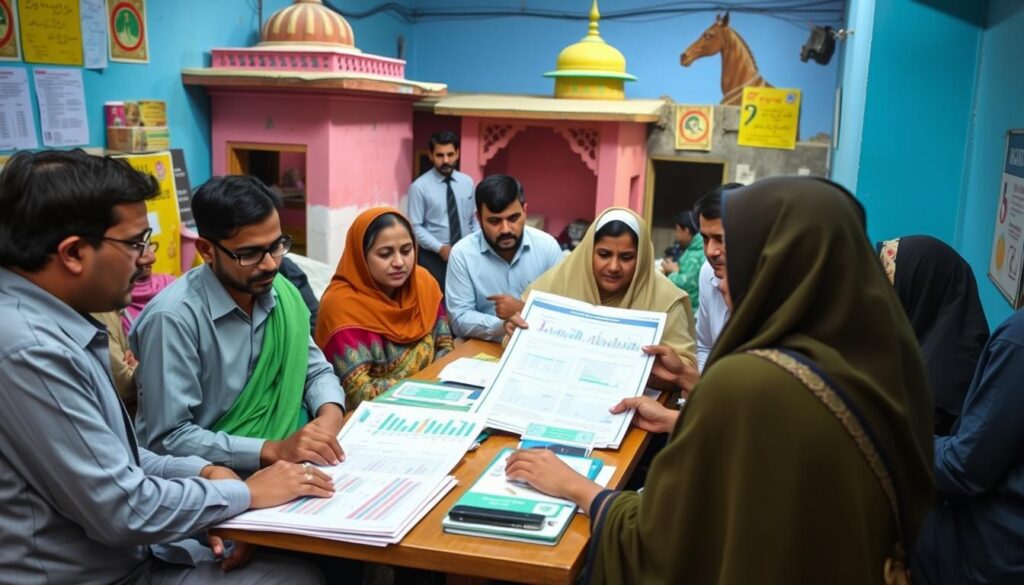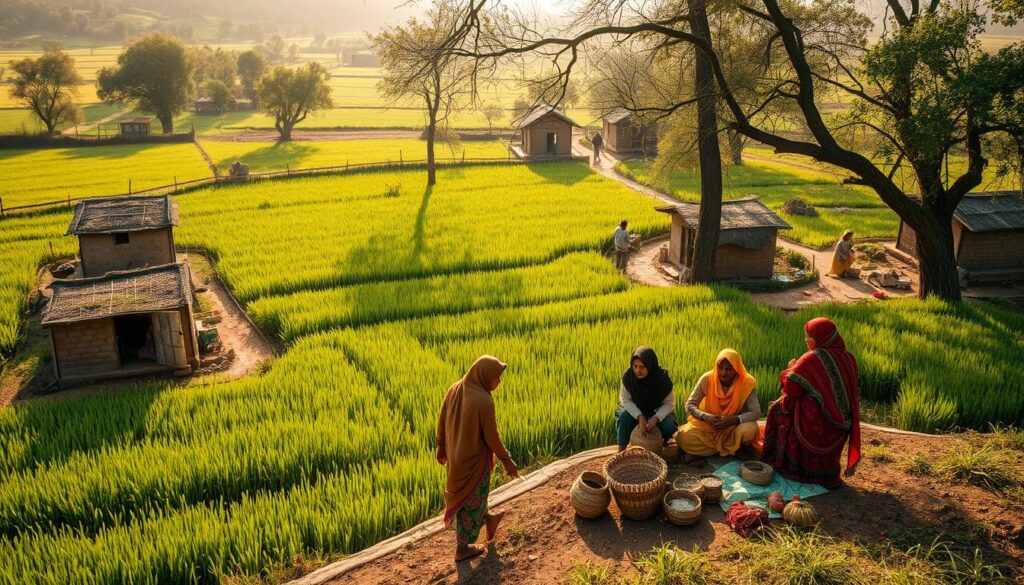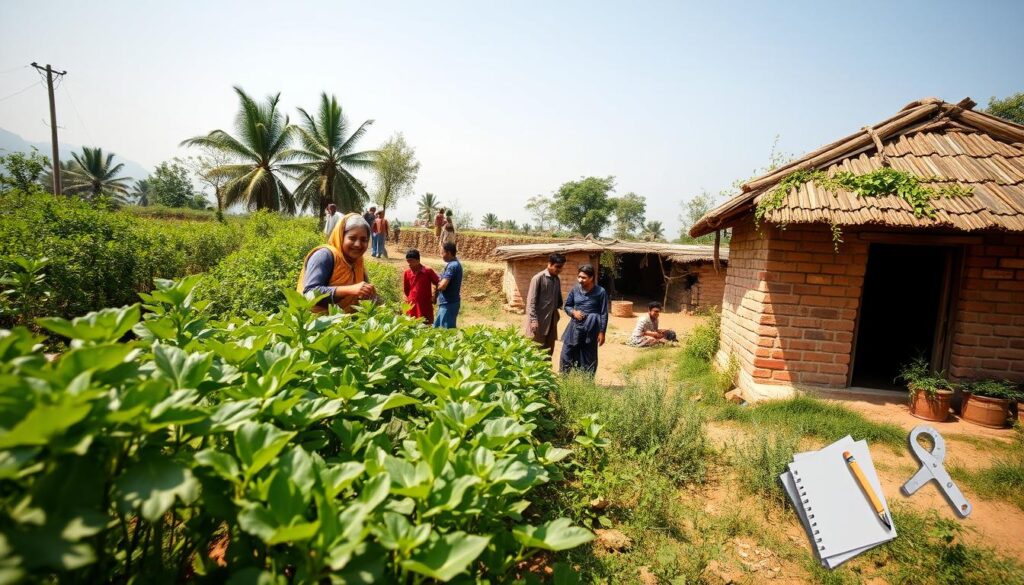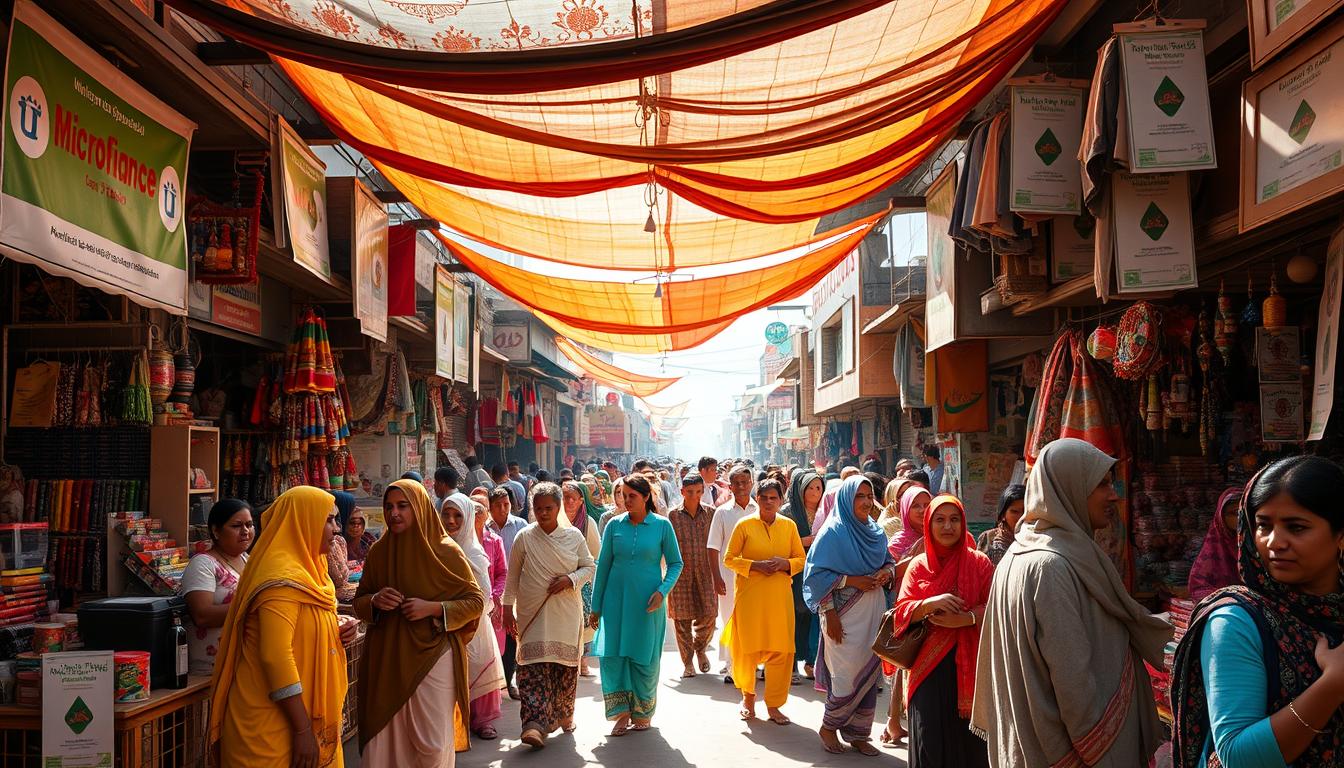Microfinance is key to financial inclusion and economic growth in Pakistan. It offers small loans and savings to those who were left out before. This has helped a lot in reducing poverty, empowering women, and growing small businesses, especially in rural areas.
The microfinance sector in Pakistan is growing fast. New products like Islamic microfinance are helping. These efforts create lasting economic chances for many. Microfinance lets people and small businesses get the money they need to do better and help Pakistan grow.
Key Takeaways
- Microfinance is vital for financial inclusion and empowering communities in Pakistan.
- It gives access to small loans, savings, and more, reaching those left out before.
- Its impact includes reducing poverty, empowering women, and growing small businesses, especially in rural areas.
- New products like Islamic microfinance have helped the sector grow and stay strong.
- Microfinance is key in creating economic chances and supporting Pakistan’s growth.
Microfinance in Pakistan: An Overview
The history of microfinance in Pakistan started in the 1980s. The first microfinance institutions were set up back then. Since then, the sector has grown a lot. It now plays a big role in bringing financial services to rural and poor areas.
History and Evolution of Microfinance in Pakistan
The microfinance industry in Pakistan has changed a lot since it began. At first, it focused on giving small loans to those who couldn’t get bank loans. As it grew, more microfinance banks, NGOs, and other groups joined. This helped microfinance reach more people across the country.
Key Players and Institutions in the Microfinance Sector
Some key players have helped the microfinance sector in Pakistan grow. These include:
- Pakistan Poverty Alleviation Fund (PPAF)
- Pakistan Microfinance Investment Company (PMIC)
- Pakistan Microfinance Investment Network (PMFIN)
These groups have helped set rules for microfinance, promoted inclusion, and supported MFIs. They’ve been crucial for the sector’s growth.
| Microfinance Institution | Focus Area | Outreach (as of 2020) |
|---|---|---|
| Pakistan Poverty Alleviation Fund (PPAF) | Poverty alleviation, community development, and microfinance | Reached over 8 million households across Pakistan |
| Pakistan Microfinance Investment Company (PMIC) | Providing wholesale funding and technical assistance to MFIs | Served over 4.5 million active borrowers |
| Pakistan Microfinance Investment Network (PMFIN) | Promoting the growth and development of the microfinance sector | Represented over 90% of the microfinance industry in Pakistan |
The work of these institutions has shaped the microfinance landscape in Pakistan. They’ve helped expand financial services to more people.

Microfinance and Financial Inclusion in Pakistan
In Pakistan, the microfinance sector has grown a lot in recent years. But, there are still big challenges to overcome, especially in rural and urban areas. Many people and small businesses can’t get to formal financial services. They often turn to informal credit or miss out on basic banking.
Barriers to Financial Inclusion in Rural and Urban Areas
There are several big hurdles for microfinance in some parts of Pakistan. Being far away is a big problem, as many rural places are hard to get to. This makes it tough for microfinance groups to set up and offer services. Also, not knowing about financial products is a big issue, as many people don’t understand formal banking.
- Geographical remoteness
- Lack of financial literacy
- Regulatory hurdles
There are also rules that make it hard for microfinance to grow in both rural and urban areas. The rules can be complex and the system is not always clear. This makes it hard for microfinance groups to operate and grow.

To solve these problems and help more people, it’s key to improve financial inclusion. This will open up economic chances for those who are left behind in both rural and urban areas of Pakistan.
Microfinance in Pakistan: Empowering Women
Microfinance has become a key tool in Pakistan, helping women and pushing for more gender inclusion. It gives women access to financial services and products made just for them. This has changed the economic scene in the country.
Microfinance has made a big difference for women in Pakistan. It has helped them move beyond traditional roles and gain financial freedom. Now, they can start and grow their own businesses, increase their family’s income, and have a say in important decisions. This financial freedom has also helped the country grow socially and economically.
Microfinance focuses on the special needs of women in Pakistan. It offers products and services designed just for them. This helps overcome issues like limited access to credit and the need for collateral.
| Indicator | Women’s Empowerment | Gender Inclusion |
|---|---|---|
| Access to Financial Services | 30% | 40% |
| Household Decision-Making Power | 45% | 55% |
| Entrepreneurial Activity | 25% | 35% |
Microfinance has changed Pakistan’s social and economic scene. As women become more financially independent and have more say, they can help their communities and the country grow.
“Microfinance has been a game-changer for women in Pakistan, providing them with the tools and resources to become active participants in the economy and shape their own destinies.”
The success of microfinance in empowering women in Pakistan shows the power of financial solutions that include everyone. As the sector grows, there’s hope for more progress in women’s empowerment and gender inclusion in Pakistan.

The Impact of Microloans on Poverty Alleviation
Microfinance has made a big difference in Pakistan, helping many people out of poverty. Small loans have given individuals and families the chance to start or grow their businesses. This has improved their economic situation.
These loans have a ripple effect, boosting incomes and access to important services like healthcare and education. These success stories show how microfinance can help people escape poverty. It creates lasting economic chances, especially in rural and less served areas of Pakistan.
Microcredit Impact in Pakistan
Take Fatima, a farmer in rural Punjab. A microcredit loan helped her buy better seeds and fertilizers. Her crops grew more, and she could earn more and invest in her kids’ education.
Zainab, a widow from a remote village, started a poultry farm with a microcredit loan. Her business brought in extra money. It helped her save for emergencies and her kids’ future, showing how microfinance can change lives in Pakistan.

“Microfinance has been a game-changer for us, allowing us to pursue our dreams and build a better life for our families.”
– Fatima, a small-scale farmer in rural Punjab
Microfinance in Pakistan: Challenges and Opportunities
The microfinance sector in Pakistan faces many challenges. High costs, limited access in remote areas, and weak rules are major hurdles. These issues have slowed its growth and reach.
Yet, there are big chances for growth and new ideas. The Pakistani government is helping a lot. It has set up the Pakistan Poverty Alleviation Fund (PPAF) and made rules that help MFIs.
Regulatory Frameworks and Government Initiatives
The microfinance regulation pakistan is key to the industry’s growth. The government has launched many plans to help MFIs grow. These include:
- Creating the Pakistan Poverty Alleviation Fund (PPAF) to give money, help, and training to MFIs.
- Starting the Microfinance Investment and Innovation Fund (MIIF) to bring more financial services to poor areas.
- Government initiatives pakistan like the National Financial Inclusion Strategy aim to get more people to use financial services.
These microfinance opportunities pakistan could really help the sector grow. They could also bring more financial services to those who don’t have them.
| Microfinance Challenges in Pakistan | Microfinance Opportunities in Pakistan |
|---|---|
|
|
By tackling the microfinance challenges pakistan and using the microfinance opportunities pakistan, the sector can help Pakistan’s economy grow. It can also help more people get financial services.
Innovations in Microcredit and Islamic Microfinance
The microfinance sector in Pakistan has seen big changes. Microcredit and Islamic microfinance have grown a lot. These changes have helped more people get financial help and have given power to those who were left out.
Microcredit offers small loans without needing collateral. It has helped reach out to far-off places and support new business owners. This has given people and small businesses a chance to follow their dreams and help the economy grow.
The Islamic microfinance sector has also grown a lot in Pakistan. It follows Sharia law and meets the needs of Muslims. This has made financial services more fair and sustainable for everyone.
New ways of lending and products have helped meet the needs of many people in Pakistan. Microcredit and Islamic microfinance have been able to reach more people. They have done this by understanding and respecting different cultures and preferences.
The growth in microfinance in Pakistan has brought more people into the financial world. It has helped people feel empowered and has led to better living conditions. As the industry keeps growing, microcredit and Islamic microfinance will open up even more chances for everyone to grow and succeed.
| Innovation | Description | Key Benefits |
|---|---|---|
| Microcredit | Small, collateral-free loans designed to support entrepreneurs and small businesses |
|
| Islamic Microfinance | Financial services that align with the principles of Sharia law, catering to the Muslim-majority population |
|
The mix of microcredit and Islamic microfinance has changed Pakistan’s microfinance world. It has brought new chances for growth that is fair and includes everyone.
Microfinance in Pakistan: Role in Small Business Development
Microfinance has changed the game for small businesses and micro-enterprises in Pakistan. It offers affordable credit, savings, and more. This has empowered entrepreneurs to grow their businesses.
This growth has positively impacted local economies. It has created jobs, raised incomes, and encouraged economic diversity.
Microfinance for Entrepreneurs and Micro-Enterprises
Microfinance institutions have tailored their services for small business owners. They offer loans, savings, and insurance plans. These services meet the unique needs of entrepreneurs, helping them grow and contribute to Pakistan’s economy.
A study shows that small business loans pakistan have helped over 50,000 micro-enterprises. Microfinance for entrepreneurs pakistan and microfinance for micro-enterprises pakistan have empowered women and marginalized groups. They have helped them start and grow their businesses.
“Microfinance has been the backbone of our small business, allowing us to invest in new equipment and expand our customer base. Without this support, it would have been nearly impossible to grow our enterprise.”
– Fatima Akhtar, Owner of a Textile Micro-Enterprise in Faisalabad
The impact of microfinance on small businesses in Pakistan is clear. It has given entrepreneurs the financial tools they need. This has helped them overcome challenges, innovate, and contribute to the nation’s prosperity.
| Indicator | Value |
|---|---|
| Number of Active Borrowers (Microfinance) | 7.9 million |
| Percentage of Women Borrowers | 73% |
| Loans to Micro-Enterprises | PKR 300 billion |
| Annual Growth Rate of Micro-Enterprise Lending | 25% |
Sustainable and Inclusive Growth with Microfinance
The impact of microfinance in Pakistan is huge. It helps with sustainable development Pakistan and inclusive growth Pakistan. Microfinance gives financial help to those who need it most. This helps them find jobs, reduce poverty, and feel included.
As microfinance grows, it can help reach the United Nations’ goals. These goals include fighting poverty, helping women, and creating jobs. By working with other programs and using new tech, microfinance can make a big difference. This will lead to a better life for everyone in Pakistan.
“Microfinance has the power to unlock economic opportunities, reduce poverty, and promote social and financial inclusion in Pakistan.”
Microfinance gives people, especially women, a chance to start businesses. It helps them invest in their families and communities. This helps Pakistan grow in a way that includes everyone.
Innovative Approaches to Microfinance
In Pakistan, microfinance is getting creative. It’s using Islamic microfinance and digital tech. These new ways help more people get the financial help they need.
The microfinance impact Pakistan is getting bigger. It’s key for sustainable development Pakistan and inclusive growth Pakistan. Microfinance empowers people, builds strong communities, and encourages new businesses. It’s changing Pakistan’s economy for the better.
Microfinance in Pakistan
Microfinance is a key tool for financial inclusion and economic growth in Pakistan. It offers small loans and financial services to communities left out by the formal banking system. This has greatly helped in reducing poverty, empowering women, and boosting small businesses, especially in rural areas.
The microfinance sector in Pakistan has grown a lot. More people are now borrowing and saving money. New products like Islamic microfinance have also helped reach more people, meeting their financial and religious needs.
| Indicator | 2017 | 2018 | 2019 |
|---|---|---|---|
| Active Borrowers (in millions) | 6.2 | 6.8 | 7.3 |
| Active Savers (in millions) | 8.1 | 8.9 | 9.5 |
| Gross Loan Portfolio (in billion PKR) | 233 | 261 | 290 |
Microfinance has made a big difference in Pakistan. It has improved the lives of many, especially in rural areas. Loans have helped create jobs, empower women, and grow small businesses, which are vital for the economy.
“Microfinance has given me the opportunity to start my own small business and support my family. Without this access to credit, I would not have been able to achieve financial independence.”
Even with progress, there are still challenges. Ensuring everyone has access to microfinance is key. The government, regulators, and microfinance groups must work together to overcome these hurdles. This will help unlock the full potential of microfinance in Pakistan.
Conclusion
Microfinance plays a huge role in Pakistan’s growth. It helps people get financial services, start businesses, and grow the economy. This growth is not just for a few but for many.
Looking ahead, combining microfinance with other efforts is key. Using new tech and improving rules will help more people benefit. This will make a big difference in Pakistan’s future.
This article shows how big of a deal microfinance is in Pakistan. It helps people, businesses, and the economy grow. As it keeps getting better, it will help even more people and businesses.
FAQ
What is the history and evolution of microfinance in Pakistan?
Microfinance in Pakistan started in the 1980s with the first institutions. Since then, it has grown a lot. Now, there are specialized banks, NGOs, and other groups helping out.
Who are the key players and institutions in the microfinance sector in Pakistan?
Important players include the Pakistan Poverty Alleviation Fund (PPAF) and the Pakistan Microfinance Investment Company (PMIC). They help bring financial services to rural and underserved areas. They also help shape the rules for microfinance in Pakistan.
What are the barriers to financial inclusion in rural and urban areas of Pakistan?
Despite progress, challenges remain in Pakistan. Many people still can’t get to formal banks. This is because of where they live, lack of knowledge, and rules.
How has microfinance empowered women in Pakistan?
Microfinance has helped women in Pakistan a lot. It gives them financial services and lets them join the economy. This has helped them start businesses, earn more, and make decisions at home.
What is the impact of microloans on poverty alleviation in Pakistan?
Microloans have made a big difference in Pakistan. They have helped people start or grow businesses. This has improved their lives and helped them get out of poverty.
What are the challenges and opportunities in the microfinance sector in Pakistan?
The sector faces high costs and reaching remote areas is hard. But, there are chances for growth and new ideas. The government is supporting the industry, and technology can help more people get financial services.
What are the innovations in microcredit and Islamic microfinance in Pakistan?
Pakistan has seen new things in microfinance. Microcredit offers small loans without needing collateral. Islamic microfinance follows Sharia law and helps more people, especially Muslims.
How has microfinance supported the development of small businesses and micro-enterprises in Pakistan?
Microfinance has been key for small businesses in Pakistan. It gives them credit, savings, and other services. This helps them grow, create jobs, and increase incomes.
How can microfinance contribute to sustainable and inclusive economic growth in Pakistan?
Microfinance can help Pakistan grow in a fair way. It reaches people who need it most, helping them and reducing poverty. Working with other efforts and using technology can make it even better.
- Microfinance in Pakistan: An Overview
- Microfinance and Financial Inclusion in Pakistan
- Microfinance in Pakistan: Empowering Women
- The Impact of Microloans on Poverty Alleviation
- Microfinance in Pakistan: Challenges and Opportunities
- Innovations in Microcredit and Islamic Microfinance
- Microfinance in Pakistan: Role in Small Business Development
- Sustainable and Inclusive Growth with Microfinance
- Microfinance in Pakistan
- Conclusion
- FAQ
